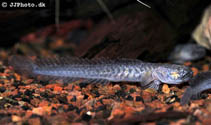| Family: |
Gobiidae (Gobies), subfamily: Gobionellinae |
| Max. size: |
55.3 cm TL (male/unsexed); max.weight: 311.0 g |
| Environment: |
demersal; freshwater; brackish; marine, amphidromous |
| Distribution: |
Western Atlantic: Charleston, South Carolina southward to Florida, along the Gulf of Mexico coasts of Alabama, Mississippi, Louisiana, and eastern-central Texas; along the Caribbean coast of Colombia, eastward to Venezuela, Surinam, Guyana, French Guiana, and Brazil as far south as Rio Grande do Sul, Brazil. |
| Diagnosis: |
Dorsal spines (total): 7-7; Dorsal soft rays (total): 15-16; Anal spines: 1-1; Anal soft rays: 15-16. Scales in longitudinal series about 160 (Ref. 27974). With a continuous dorsal fin, and dorsal and anal fins joined with caudal fin (Ref. 26938). |
| Biology: |
Adults prefer muddy bays and estuaries; encountered in fresh water (Ref. 13628), with a salinity range of 0.0 to 25.5 ppt (Ref. 97140). Also found offshore on muddy bottoms, off mouths of large rivers. Largest goby in the Caribbean, and the only one with this distinctive eel-like shape (Ref. 26938). |
| IUCN Red List Status: |
Least Concern (LC); Date assessed: 28 February 2019 Ref. (130435)
|
| Threat to humans: |
harmless |
| Country info: |
|
Source and more info: www.fishbase.org. For personal, classroom, and other internal use only. Not for publication.

